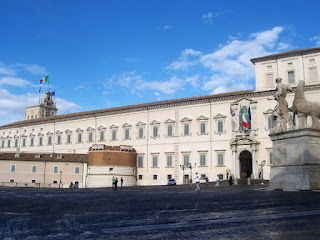Sonia Gandhi - Indian politician
__________________________________
Baldassare Ferri – singer
Male soprano was admired by the crowned heads of Europe
Castrato singer Baldassare Ferri was born on this day in 1610 in Perugia in the region of Umbria. He is said to have possessed a beautiful soprano voice that was praised by other musicians and by much of the aristocracy of Europe. The Holy Roman Emperor Leopold I, who was a great patron of music and himself a composer, is believed to have become so enchanted with Ferri that he had a portrait of the singer hung in his bedroom with the inscription, Baldassare Ferri, Re dei Musici (King of Musicians). By the age of 11, Ferri was a chorister serving Cardinal Crescenzi in Orvieto. He then studied music in Naples and in Rome, where he was taught by Vincenzo Ugolini of Perugia, who was maestro of the Cappella Giulia. Prince Wladislaus of Poland then secured Ferri’s services for the court of King Sigismund III at Warsaw, where the singer took part in dramas set to music. He continued to be employed at the court when the prince became King Wladislaus IV Vasa in 1632. A few years later Ferri moved to Vienna, where he entered the services of the Emperor Ferdinand III and afterwards sang for the Emperor Leopold I. Read more…
______________________________________
Bruno Ruffo - motorcycle racer
Italy's first world champion on two wheels
Motorcycle racer Bruno Ruffo, winner of the inaugural 250cc World Championship in 1949, was born on this day in 1920 in Colognola ai Colli, a village in the province of Verona. He shares with Nello Pagani the distinction of being Italy's first world champion motorcyclist, Pagani having won the first world title in the 125cc class in the same year. Ruffo wanted to race from the age of eight, having become fascinated with the motorcycles and cars that his father repaired in his workshop. He was able to drive a car at the age of 10 and was given his first motorcycle by his father as a 16th birthday present. He entered a race for the first time the following year at Montagnana near Padua and won. The minimum age for participants was 18 and it later transpired he had falsified his identity papers to take part. The Second World War interrupted his progress. Drafted into the Italian Army, Ruffo served for 20 months on the Russian front. After the war, he bought a Moto Guzzi 250, which he raced privately, enjoying considerable success in 1946, when he won nine of the 11 races he entered in the cadet class. Read more…
_______________________________________
Carlo Azeglio Ciampi - prime minister and president
The politician who took Italy into the euro
The politician and banker, Carlo Azeglio Ciampi, was born on this day in 1920 in Livorno. He was the 49th prime minister of Italy between 1993 and 1994 and the tenth president, in office from 1999 to 2006. Ciampi studied ancient Greek literature in Pisa, before being called up to do military duty, but in 1943 he refused to stay with the Fascists and took refuge in Abruzzo. He managed to get to Bari, where he joined the Italian resistance movement. After the war, he gained a doctorate in law from Pisa University and began working at the Banca d’Italia. He went on to become Governor of the bank and then President of the National Bureau de Change. Ciampi was the first-non parliamentarian prime minister of Italy for more than 100 years, appointed by the President, Oscar Luigi Scalfaro, to oversee a technical government. Later, as the treasury minister under Romano Prodi and Massimo d’Alema, Ciampi, a staunch supporter of the EU, adopted the euro currency for Italy. When he was elected president, he had a broad majority and was only the second president ever to be elected at the first ballot. Read more…
_________________________________________
Teofilo Folengo – poet
Style of writer’s verses took its name from the dumpling
Teofilo Folengo, who is remembered as one of the principal Italian ‘macaronic’ poets, died on this day in 1544 in the monastery of Santa Croce in Campese, a district of Bassano del Grappa in the Veneto. Folengo published, under the pseudonym Merlin Cocaio, a macaronic narrative poem entitled Baldo, which was a humorous send-up of ancient epic and Renaissance chivalric romance. Writing in verse that mixed vernacular language with Latin became known as macaronic verse, the word deriving from the Latin macaronicus and the Italian maccarone, which meant dumpling, fare mixed crudely from different ingredients that at the time was regarded as a coarse, peasant food. It is presumed to be the origin of the modern Italian word maccheroni. Folengo was a runaway Benedictine monk who satirised the monastic life using an invented, comic language that blended Latin with various Italian dialects. Born Girolamo Folengo in 1491 in Cipada, a village near Mantua, he entered the Benedictine order as a young man taking the name Teofilo. He lived in monasteries in Brescia, Mantua and Padua. Read more…

.jpg)
.jpg)


.jpg)


%20(2).jpg)




.jpg)

_-_2021-08-29_-_1%20(2).jpg)
.JPG)




.jpg)



.jpg)
_Italian_violinist,_composer,_music_theorist.jpg)
.jpg)

.jpg)

.jpg)
.jpg)
